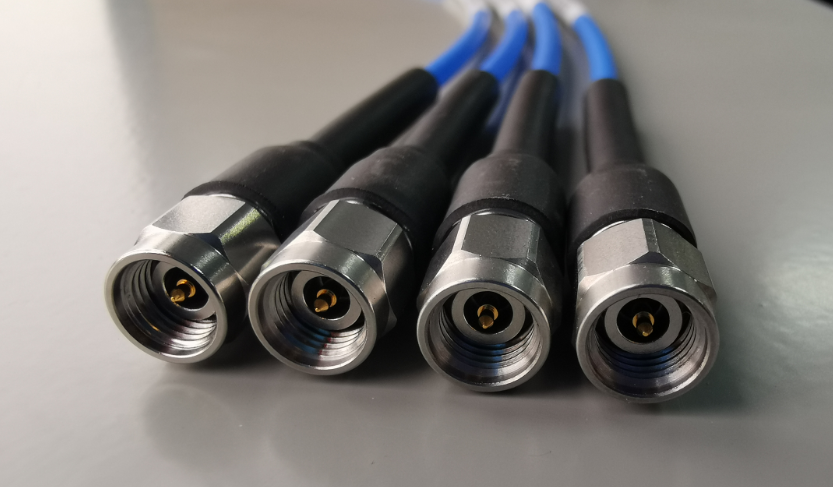Coaxial cable is the most commonly used transmission line for RF and microwave applications, because it provides reliable transmission with the benefits of wide bandwidth and low loss and high isolation. Major manufacturers of transmitting equipment, i.e. radio and TV, radar, GPS, emergency management systems, air and marine craft, use coaxial cables. The uses of coaxial cable apply to any system in which signal loss and attenuation must be minimized. Unlike waveguides, coaxial cable has no lower cutoff frequency but what about its upper frequency?
Frequency
Like other parts of the electromagnetic spectrum, radio frequency (RF) is identified by its frequency in Hertz (Hz) or wavelength in meters. An inverse relationship exists between these two concepts such that as frequency increases, wavelength decreases, with the reverse being true as well. The strength of a radio frequency signal is measured in Watts. A frequency band refers to a designated section of the RF spectrum like, for example, the AM and FM band used in radio broadcasting and, within this band, a section of spectrum is referred to as bandwidth. Frequency is identified as the number of reverses or cycles in the flow of alternating current (AC) per second. For example, broadcast stations operate at frequencies of thousands of cycles per second and their frequencies are called kilohertz (kHz); higher frequencies are in millions of cycles per second and are called megahertz (MHz). Radio frequency is the frequency band which is primarily used for transmission of radio and television signals and ranges from 3 MHz to 3 GHz. Microwave frequencies range from Ultra-High Frequency (UHF) 0.3 – 3 GHz, Super High Frequency (SHF) 3 – 30 GHz to Extremely High Frequency (EHF) 30 – 300 GHz.
Max Frequency
With some exceptions, most coaxial cables do not have an actual cut-off terms of a specific stop-band frequency but instead use the term cutoff to refer to the highest frequency tested by the manufacturer, or when the frequency reaches a point where the coaxial cable becomes a waveguide and other modes, aside from the transverse-electromagnetic mode (TEM), occur. Hence, a coaxial cable cutoff frequency could be where the coaxial cable remains within specification, or within a reasonable margin to avoid transverse-magnetic (TM) or transverse-electric (TE) propagation modes. Though coaxial cables can still carry signals with frequencies above the TEM mode cutoff, TM or TE transmission modes are much less efficient not desirable for most applications.
Cutoff Frequency and Skin-Depth
Two important concepts of note when discussing frequency in coaxial cable are skin-depth and cutoff frequency. Coaxial cable is made up of two conductors, an inner pin, and an outer grounded shield. Skin depth occurs along the coaxial line when high frequencies cause electrons to migrate towards the surface of the conductors. This skin effect leads to increased attenuation and dielectric heating and causes greater resistive loss along the coaxial line. To reduce the losses from the skin affect, a larger diameter coaxial cable can be used but increasing the coaxial cables dimensions will reduce the maximum frequency the coaxial cable can transmit. The problem is that when the size of the wavelength of electromagnetic energy exceeds the transverse electromagnetic (TEM) mode and begins to “bounce” along the coaxial line as a transverse electric 11 mode (TE11), the coaxial cable cut-off frequency is created. Because the new frequency mode travels at a different velocity than the TEM mode, it creates reflections and interference to the TEM mode signals traveling through the coaxial cable. This is referred to as the upper frequency limit or cutoff frequency.
A cutoff frequency is a point at which energy flowing through the EM system begins to be reduced, by attenuation or reflected, rather than passing through the line. TE and TM modes are the lowest order mode propagating on a coaxial line. In TEM mode, both the electric field and the magnetic field are transverse to the direction of travel and the desired TEM mode is allowed to propagate at all frequencies. Higher modes are excited at frequencies above the cutoff frequency when the first higher-order mode, called TE11, is also allowed to propagate. To be sure that only one mode propagates for a clear signal, the signals need to be below the cutoff frequency. Reducing the size of the coaxial cable increases the cut-off frequency. Coaxial cables and coaxial connectors can reach into the millimeter wave frequencies but as the physical dimensions shrink, power handling capabilities are reduced and losses increase.

同轴电缆最大频率有多高?
